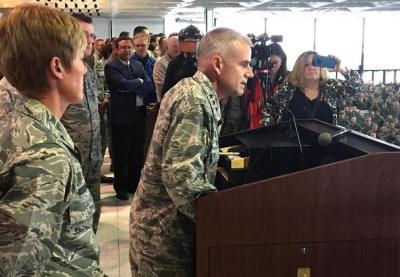In a viral video that electrified social media today, Lt. General Jay Silveria of the United States Air Force showed all of us what leadership in the face of hate looks like. After the n-word was written on message boards on the dormitory doors of black students at the Air Force Academy Prep School, Silveria assembled the entire cadet corps, faculty, airstrip personnel and staff at the 10th Air Base Wing to denounce the act and affirm the institution’s values.
Silveria’s was a textbook response—if your textbook is something like Responding to Hate and Bias at School. The guide—a copy of which we sent to every principal and superintendent in the country last February—provides a blueprint of what to do when an incident like the one at the prep school happens.
What happened at the Air Force Academy prep school is now commonplace at schools, public and private, across the country. It’s in the news and on educators’ tongues. I speak regularly with leaders of educational organizations, from Facing History and Ourselves to the Anti-Defamation League and from the American Federation of Teachers to the National Educational Association. We’re all hearing about an increase in harassment, slurs and hateful graffiti, and the lackluster response from school leaders.
Many of these incidents aren’t reported. Instead, teachers are being told not to talk about the swastikas that were quickly painted over and to keep secret the noose found on a locker. In places where the incidents get posted to social media, too many school leaders treat them as isolated mischief perpetrated by a few bad apples and assure the public that appropriate discipline has been taken.
Silveria didn’t focus on the bad apples; he focused on the behavior and the institution’s values. That’s step one in our guide: “First, denounce the act.”
To denounce the act, of course, requires talking about what happened. Silveria did that right away:
You may have heard that some people down at the prep school wrote some racial slurs on some message boards. If you haven’t heard that, I want you to hear it from me. If you’re outraged by those words, then you’re in the right place.
Next, he modeled the response he wished to see from his cadets:
You should be outraged, not only as an airman, but as a human being. And I’ll tell you … the appropriate response for horrible language and horrible ideas: The appropriate response is a better idea.
Silveria delivered his message in a public forum, with Academy leadership, including two brigadier generals, present to make it clear that the entire institution stood for the values he proclaimed:
[Leadership is all here] because we have a better idea.
He didn’t sugarcoat the realities or pretend that our nation isn’t confronting racial issues:
… We would be naïve to think that everything is perfect here. We would be naïve to think that we shouldn’t discuss this topic. We would also be tone-deaf not to think about the backdrop of what’s going on in our country. Things like Charlottesville and Ferguson, the protests in the NFL. That’s why we have a better idea.
And he defined the “better idea,” one that aligns with fundamental democratic values:
What we should have is a civil discourse, and talk about these issues. That’s a better idea.
I also have a better idea, and it’s about our diversity. And it’s the power of the diversity … the power of us as a diverse group. The power that we come from all walks of life, that we come from all parts of this country, that we come from all races, we come from all backgrounds, gender … the power of that diversity comes together and makes us more powerful.
That’s a much better idea than small thinking and horrible ideas.
There’s a lot school leaders can learn from Silveria’s response to a horrible incident at his school, but there is also a notable difference. School leaders cannot—and should not—tell students, “If you can’t treat someone with dignity and respect, then leave.” Public schools are for everyone. And they are preparing young people to live in a diverse democracy, not to serve in the military. Educators work hard every day to convince students to stay in school, and aspire to make them more inclusive.
But inclusion leaves no room for hate, disrespect or rejecting human dignity. School leaders can’t demand that students leave, but they can set clear expectations, give voice and provide leadership to support a culture of better ideas.
Silveria ended his talk by inviting cadets to take out their phones and video his message as a reminder about the institution’s values and his words.
I encourage school leaders to download that video and keep it handy. Better yet, look at those words, practice saying them with the conviction that Silveria displayed, and turn the video on yourself.
Your students and community need your voice and leadership.
Costello is the director of Teaching Tolerance.

